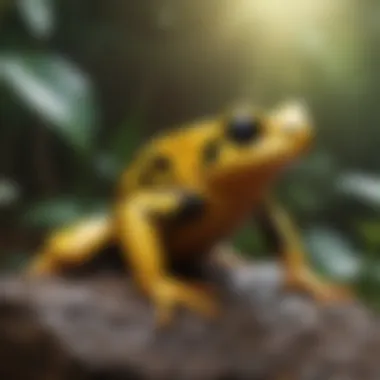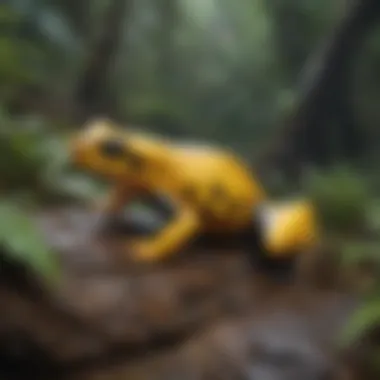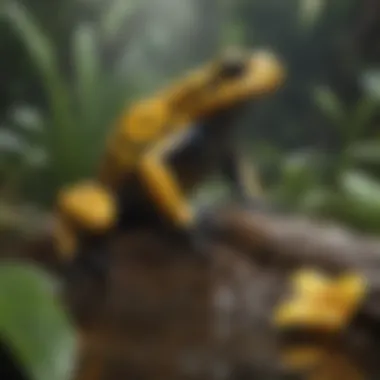Unveiling the Enigmatic Diet of the Golden Poison Dart Frog


Nature Topic Overview
Fun Facts and Trivia
- The Golden Poison Dart Frog, despite its diminutive size, possesses potent skin toxins that serve as a defense mechanism against predators. These toxins are derived from the specialized diet of the frog, consisting mainly of tiny insects like ants and beetles. Learning about these toxins and their origin can offer young readers a glimpse into the fascinating adaptations of this remarkable amphibian.
- Visuals depicting the colorful and diverse diet of the Golden Poison Dart Frog, combined with interactive elements such as quizzes on insect types consumed by the frog, can enhance the learning experience and engage children in the captivating world of amphibian feeding behaviors.
Wildlife Explorations
In the lush rainforests where the Golden Poison Dart Frog resides, a myriad of species coexist, forming a complex ecosystem interconnected through predator-prey relationships. Exploring the dietary habits of other creatures in the frog's habitat, such as the insects it preys on or the plants it interacts with, provides valuable insights into the intricate web of life within these biodiverse regions. Quizzes or puzzles focusing on the dietary connections between different species can enrich children's understanding of wildlife interactions.
Environmental Awareness
The conservation of species like the Golden Poison Dart Frog is essential for maintaining the delicate balance of ecosystems. By understanding the impact of human activities on amphibian habitats and the urgency of conservation efforts, children can develop a sense of environmental awareness and responsibility. Offering tips on how young individuals can contribute to nature conservation, whether through reducing pollution or supporting habitat preservation initiatives, empowers them to make a positive difference in the natural world.
DIY Nature Activities
Engaging in hands-on activities related to amphibian diets can deepen children's appreciation for nature and wildlife. Creating insect-inspired crafts or conducting experiments to understand the nutritional requirements of frogs fosters a sense of curiosity and exploration. Step-by-step guides for designing frog-friendly habitats or suggestions for outdoor explorations to identify insect species can encourage practical application of learned knowledge, enriching the learning experience for young nature enthusiasts.
Introduction
Diving into the intricacies of the diet of the Golden Poison Dart Frog unveils a world of marvels and mysteries. Understanding the dietary habits of this mesmerizing amphibian species not only sheds light on its feeding preferences but also provides valuable insights into its survival strategies. Through a detailed exploration of the Golden Poison Dart Frog's diet, we aim to decipher the underlying mechanisms that drive its nutritional choices and unravel the significance of food sources in its ecosystem.


Overview of the Golden Poison Dart Frog
The Golden Poison Dart Frog, with its vibrant hues and intriguing behaviors, stands out as a captivating creature in the realm of amphibians. Endemic to the rainforests of South America, particularly Colombia, this species boasts unique characteristics that set it apart from its counterparts. From its striking coloration to its toxic skin secretions, the Golden Poison Dart Frog intrigues both scientists and nature enthusiasts, making it a focal point of ecological studies and conservation efforts.
Significance of Studying its Diet
Studying the diet of the Golden Poison Dart Frog offers a gateway to understanding its ecological role and evolutionary adaptations. By delving into the feeding habits of this species, researchers can unravel the intricate interplay between diet, behavior, and survival strategies. Additionally, analyzing the nutritional preferences of the Golden Poison Dart Frog provides crucial insights into the broader food web dynamics of its habitat, highlighting the interconnected nature of ecosystems and the significance of conserving biodiversity for future generations.
Natural Habitat of the Frog
Exploring the diet of the mesmerizing Golden Poison Dart Frogs entails delving deep into their natural habitat, a critical element influencing their dietary habits. These amphibians predominantly inhabit the lush tropical rainforests of South America, thriving amidst the dense vegetation and vibrant ecosystem. The intricacies of their surroundings play a pivotal role in shaping their feeding preferences and foraging behavior.
Description of Habitat
The natural habitat of the Golden Poison Dart Frog comprises a diverse range of microenvironments, including leaf litter, forest floors, and tree canopies. These frogs are known to seek shelter under fallen leaves and rocks, utilizing their surroundings for protection and hunting. The intricate web of their habitat provides abundant opportunities for feeding and breeding, ensuring their survival amidst the dynamic rainforest ecosystem.
Impact of Habitat on Diet
The habitat of the Golden Poison Dart Frog greatly influences its diet, with the abundance of insects and arthropods in the rainforest serving as primary food sources for these amphibians. The varied microhabitats within their environment offer a diverse array of prey, allowing the frogs to adapt their feeding behaviors based on availability. Furthermore, the dense vegetation and moisture content in their habitat contribute to the proliferation of insect species, ensuring a steady supply of nutrition for the frogs.
Dietary Preferences of the Golden Poison Dart Frog
The dietary preferences of the captivating Golden Poison Dart Frog are a focal point of this comprehensive exploration. Understanding the intricate details of its feeding choices provides us with invaluable insights into the survival mechanisms of this fascinating amphibian species. By delving into the nuances of its diet, we unravel a tapestry of complexities that underscore the importance of diet in the ecosystem.


Primary Diet Sources
The primary diet sources for the Golden Poison Dart Frog predominantly revolve around insects and arthropods. These tiny creatures serve as the mainstay of the frog's nutritional intake, offering a rich source of proteins and other essential nutrients. Insects and arthropods play a pivotal role in sustaining the health and vitality of these amphibians, showcasing a delicate balance between predator and prey in their natural habitat.
Insects and Arthropods
Insects and arthropods represent a cornerstone of the Golden Poison Dart Frog's diet, providing a diverse array of nutritional benefits essential for its well-being. The high protein content found in these small creatures fuels the energy requirements of the frog, enabling it to thrive in its environment. Their role as primary food sources highlights the intricate web of interactions within the ecosystem, emphasizing the significance of each organism's contribution.
Variation in Diet Based on Life Stage
The variation in diet based on life stage, particularly between tadpoles and adults, offers a compelling insight into the dietary adaptation of the Golden Poison Dart Frog. While tadpoles predominantly feed on aquatic plants and algae, adults shift towards a carnivorous diet, preying on insects and other small invertebrates. This transition reflects the developmental milestones of the frog, adapting its diet to meet the changing physiological demands as it progresses through life.
Tadpoles vs. Adults
Contrasting the specific dietary requirements of tadpoles and adults underscores the adaptive flexibility of the Golden Poison Dart Frog. Tadpoles rely on plant-based nutrition to support their growth and development, whereas adults prioritize animal-based sources to sustain their energy needs. This distinctive dietary shift serves as a testament to the frog's remarkable ability to adapt to varying ecological conditions, optimizing its survival strategies in a dynamic environment.
Nutritional Requirements and Adaptations
Key Nutrients for Survival
Comprehending the Key Nutrients essential for the Golden Poison Dart Frog's survival illuminates the intricate web of dependencies that sustain this tiny marvel of nature. From proteins vital for growth and tissue repair to carbohydrates providing energy for daily activities, each nutrient plays a specific role in bolstering the frog's physiological functions. Micronutrients like vitamins and minerals act as catalysts, facilitating crucial biochemical reactions within the frog's body. Additionally, water stands as a foundational nutrient ensuring proper hydration and metabolic processes. Ultimately, a balanced intake of these Key Nutrients is imperative for upholding the Golden Poison Dart Frog's health and longevity.
Adaptations for Efficient Foraging


Unveiling the Adaptations honed by the Golden Poison Dart Frog unveils a tapestry of clever mechanisms tailored for efficient foraging in its habitat. From specialized tongue structures optimized for capturing elusive prey to heightened sensory capabilities aiding in prey detection, these adaptations showcase the frog's evolutionary prowess. Camouflage techniques perfected over generations enable these amphibians to blend seamlessly into their surroundings, evading predators and enhancing hunting success. Furthermore, metabolic adaptations allow for the efficient utilization of nutrients from prey items, maximizing energy gain and promoting overall fitness. The amalgamation of these adaptations underscores the Golden Poison Dart Frog's remarkable ability to navigate its ecological niche with finesse.
Interactions with Other Species
Understanding the interactions of the Golden Poison Dart Frog with other species is vital to appreciating its place in the ecosystem. These interactions shape the frog's behavior, diet, and survival strategies. By examining how this tiny amphibian navigates its environment alongside various species, we can gain a deeper insight into its holistic role within the ecosystem. Whether it's competing for food sources or evading predators, these interactions are key to understanding the dynamic relationships that exist in nature.
Predators and Predation Strategies
Predation plays a significant role in the life of the Golden Poison Dart Frog. Despite its bright colors that typically warn predators of its toxicity, some species have developed strategies to prey on these frogs. From snakes to birds, understanding the predators of the Golden Poison Dart Frog sheds light on the intricate balance of the ecosystem. Predation strategies vary among different species, with some employing ambush techniques while others rely on speed and agility to catch their prey. Analyzing these strategies provides a glimpse into the evolutionary arms race between predator and prey, showcasing nature's ingenuity in survival tactics.
Impact on Ecosystem Dynamics
The interactions of the Golden Poison Dart Frog with other species have a ripple effect on ecosystem dynamics. As both predator and prey, this frog influences the populations of insects and organisms in its habitat, creating a domino effect on the entire ecosystem. By studying how the presence of these frogs impacts the behavior and distribution of other species, scientists can unravel the intricate web of connections that sustain life in the rainforest. The delicate balance of predator-prey relationships and food chains is highlighted through the lens of this tiny amphibian, showcasing the interconnectedness of species and the delicate harmony required for a healthy ecosystem.
Conservation Efforts and Future Research
In the realm of the Golden Poison Dart Frog's dietary exploration, the crucial pillar of Conservation Efforts and Future Research stands tall. Understanding the dietary patterns and food sources of this mesmerizing amphibian is not merely a quest for knowledge but a quest for conservation. The future of these vibrant frogs hinges on the preservation of their natural habitats and the sustenance of their food sources.
Threats to Food Sources
Delving into the intricacies of the Golden Poison Dart Frog's diet unveils a stark reality - the looming threats to their food sources. Factors such as habitat loss, climate change, and human encroachment pose significant risks to the availability of insects and arthropods, the primary diet sources of these enchanting creatures. Safeguarding these food reservoirs is paramount to ensuring the Golden Poison Dart Frogs' continued existence in the wild.
Importance of Understanding Dietary Patterns
Peering into the dietary patterns of the Golden Poison Dart Frog not only unveils the intricacies of their feeding behavior but also unlocks a trove of valuable insights. By understanding what sustains these amphibians, we gain a deeper appreciation for the delicate balance of ecosystems. Moreover, comprehending their dietary nuances equips us with the knowledge necessary to devise conservation strategies aimed at preserving their fragile existence.
Areas for Further Study
As we traverse the landscape of Golden Poison Dart Frog dietary exploration, several uncharted territories beckon us for deeper scrutiny. Areas for further research include investigating the impact of environmental changes on their food sources, deciphering the nutritional requirements essential for their survival, and exploring the interplay between diet and coloration. By delving into these realms, we pave the path for a more profound understanding of these captivating creatures and pave the way for informed conservation efforts and future studies.







